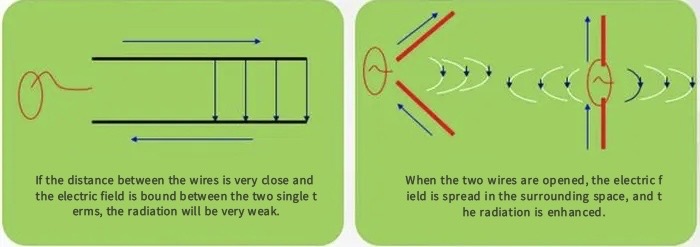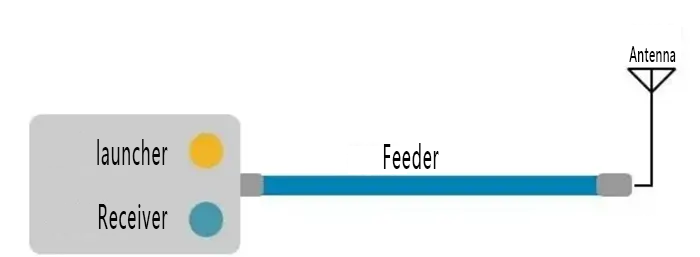Among wireless communication technologies, only the relationship between the wireless transceiver device and the antenna of the RFID system is the most special. In the RFID family, antennas and RFID are equally important members. RFID and antennas are interdependent and inseparable. Whether it is an RFID reader or RFID tag, whether it is high-frequency RFID technology or ultra-high-frequency RFID technology, it is inseparable from the antenna.
An RFID antenna is a converter that converts guided waves propagating on a transmission line into electromagnetic waves propagating in an unbounded medium (usually free space), or vice versa. An antenna is a component of radio equipment used to transmit or receive electromagnetic waves. The radio frequency signal power output by the radio transmitter is transported to the antenna through the feeder (cable), and is radiated by the antenna in the form of electromagnetic waves. After the electromagnetic wave reaches the receiving location, it is received by the antenna (only a small part of the power is received) and sent to the radio receiver through the feeder, as shown in the figure below.
The principle of radiating electromagnetic waves from RFID antennas
When a wire carries an alternating current, it will radiate electromagnetic waves, and its radiation ability is related to the length and shape of the wire. If the distance between the two wires is very close, the electric field is bound between the two wires, so the radiation is very weak; when the two wires are spread apart, the electric field is spread in the surrounding space, so the radiation is enhanced. When the length of the wire is much smaller than the wavelength of the radiated electromagnetic wave, the radiation is very weak; when the length of the wire is comparable to the wavelength of the radiated electromagnetic wave, the current on the wire increases greatly, forming stronger radiation. The above-mentioned straight wire that can produce significant radiation is usually called an oscillator, and the oscillator is a simple antenna.

The longer the wavelength of electromagnetic waves, the larger the size of the antenna. The more power that needs to be radiated, the larger the size of the antenna.
RFID antenna directivity
The electromagnetic waves radiated by the antenna are directional. At the transmitting end of the antenna, the directivity refers to the antenna's ability to radiate electromagnetic waves in a certain direction. For the receiving end, it means the antenna's ability to receive electromagnetic waves from different directions. The function graph between the antenna radiation characteristics and the spatial coordinates is the antenna pattern. Analyzing the antenna pattern can analyze the antenna's radiation characteristics, that is, the antenna's ability to transmit (or receive) electromagnetic waves in all directions in space. The directivity of the antenna is usually represented by curves on the vertical plane and the horizontal plane that represent the power of electromagnetic waves radiated (or received) in different directions.

By making corresponding changes to the internal structure of the antenna, the directivity of the antenna can be changed, thereby forming different types of antennas with different characteristics.
RFID antenna gain
Antenna gain quantitatively describes the degree to which an antenna radiates input power in a concentrated manner. From the perspective of the pattern, the narrower the main lobe, the smaller the side lobe, and the higher the gain. In engineering, antenna gain is used to measure the ability of an antenna to send and receive signals in a specific direction. Increasing the gain can increase the coverage of the network in a certain direction, or increase the gain margin within a certain range. Under the same conditions, the higher the gain, the farther the radio wave propagates.
Classification of RFID antennas
Dipole antenna: Also called a symmetrical dipole antenna, it consists of two straight wires of the same thickness and length arranged in a straight line. The signal is fed in from the two endpoints in the middle, and a certain current distribution will be generated on the two arms of the dipole. This current distribution will excite an electromagnetic field in the space around the antenna.
Coil antenna: It is one of the most widely used antennas in RFID systems. They are usually made of wires wound into circular or rectangular structures to enable them to receive and transmit electromagnetic signals.
Inductively coupled RF antenna: Inductively coupled RF antenna is usually used for communication between RFID readers and RFID tags. They couple through a shared magnetic field. These antennas are usually in a spiral shape to create a shared magnetic field between the RFID reader and the RFID tag.
Microstrip patch antenna: It is usually a thin layer of metal patch attached to the ground plane. Microstrip patch antenna is light in weight, small in size, and thin in section. The feeder and matching network can be produced at the same time as the antenna, and is closely related to the communication system. Printed circuits are integrated together, and the patches can be manufactured using photolithography processes, which are low-cost and easy to mass-produce.
Yagi antenna: is a directional antenna consisting of two or more half-wave dipoles. They are often used to enhance signal strength or conduct directional wireless communications.
Cavity-backed antenna: It is an antenna in which the antenna and feeder are placed in the same back cavity. They are commonly used in high-frequency RFID systems and can provide good signal quality and stability.
Microstrip linear antenna: It is a miniaturized and thin antenna, usually used in small devices such as mobile devices and RFID tags. They are constructed from microstrip lines that provide good performance in a smaller size.
Spiral Antenna: An antenna capable of receiving and transmitting circularly polarized electromagnetic waves. They are usually made of metal wire or sheet metal and have one or more spiral-shaped structures.
There are many types of antennas for use in different situations such as different frequencies, different purposes, different occasions, and different requirements. Each type of antenna has its unique characteristics and applicable scenarios. When selecting a suitable RFID antenna, you need to choose based on the actual application requirements and environmental conditions.
To learn more about antennas, please visit:
Phone:0086-028-82695327
Post time: May-15-2024








